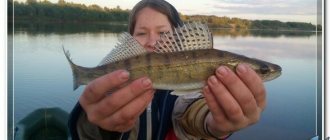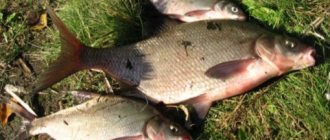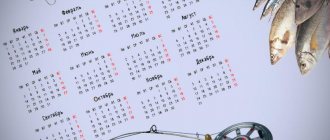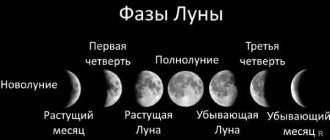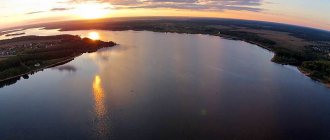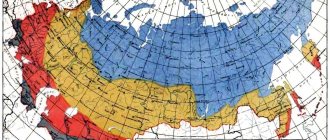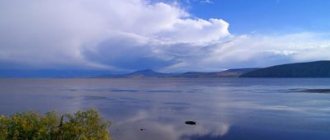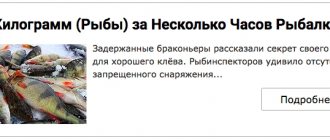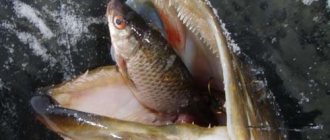History and features of the reservoir
The reservoir was created within the Moscow River in 60-62 years of the last century after a hydroelectric complex was built in this area. There is a hydroelectric power station on it. The length of the dam that blocks the river is 900 m. It serves as a road crossing, but you can drive across it only with a pass.
The Mozhaisk Sea has an elongated shape. In its waters there is Gorokhovsky Island, which is located opposite the village of Staroye Selo. The left bank of the reservoir is almost completely flat, so access to it is not difficult. The right coast has a high altitude and uneven terrain, with frequent cliffs.
The bottom of the reservoir is mostly flat, but there are numerous snags on it. The reservoir has the greatest depth in the flooded channel and in places not far from it. At the end of November, the reservoir is covered with solid ice. The period of clear water in it begins in the last weeks of April.
Previously, the Mozhaisk Sea was used for shipping. Now the reservoir is used for water supply to Moscow and serves to regulate the drainage in the river on which it was created. The reservoir is a recreation area, so recreation centers and cottage communities operate around it.
Mozhaisk Reservoir 01/30/2019. Fishing report
Author, Konstantin
Hi all. Mozhaisk Reservoir 01/30/2019, Max and I gathered for bream in Krasnovidovo (tractor bay). At 8.20 am we were already on the ice.
Right away, from the First Lines I want to Write about the Weather:
- The air temperature was -10°C;
- The wind was southeast and increasing;
- Blizzard. It was snowing. It was simply impossible to fish without a tent; it was completely swept away.
So, we came to the point, drilled 4 holes at once, and did the starting feeding. Small, fodder bloodworms were used as bait. It turned out to be 2 holes in the tent, and 2 outside.
We tried everything and they all worked great. But since the weather did not allow fishing outside, we fished exclusively in the tent. The depth at which we fished was approximately 13-14 meters. A bunch of bloodworms was used as a nozzle.
Almost 3 hours of silence, not counting the languid squeezing at the other end of the fishing line. And only at 11 o’clock the bream began to bite confidently. The frequency of bites was about half an hour, but stable. Almost all the fish were standing in half the water, we realized this from the snot on the fishing line. And only individual specimens sank to the bottom to feast on what we offered.
Maxim had 3 catches of good bream, I only had 2. Although we caught small ones, the ones that caught were much larger. It was biting almost all day. Periodically, bloodworms were poured into each hole using a dump truck. I was also pleased by the complete absence of small items.
I want to say that a regular hook with a bloodworm bit much better than a jig. In general, the Mozhaisk Reservoir, as always, did not disappoint, we had a great rest, and in the evening we already ate our catch. Good luck to all.
3 ways to improve your fish bite!

Over 15 years of active fishing, I have found many ways to improve the bite, and here are the most effective:
1. Bite activator . This pheromone additive attracts fish most strongly in cold and warm water. The Fish Hungry bite activator has proven itself to be excellent - Read more…
2. Tackle with increased sensitivity . You should first familiarize yourself with the features of using a particular type.
3. Pheromone baits . They attract the attention of fish, stimulate hunger and cause a schooling reflex, which allows you to collect a lot of fish in one place.
You can get the rest of the secrets of successful fishing for free by reading my other materials on the site.
3 ways to improve your fish bite!
Over 15 years of active fishing, I have found many ways to improve the bite, and here are the most effective:
1. Bite activator . This pheromone additive attracts fish most strongly in cold and warm water. The Fish Hungry bite activator has proven itself to be excellent - Read more…
2. Tackle with increased sensitivity . You should first familiarize yourself with the features of using a particular type.
3. Pheromone baits . They attract the attention of fish, stimulate hunger and cause a schooling reflex, which allows you to collect a lot of fish in one place.
You can get the rest of the secrets of successful fishing for free by reading my other materials on the site.
Maps were disabled by the visitor on this site. Click to open the map in a new window.
Fishing
The Mozhaisk Reservoir is home to about 30 species of fish. Among them there are both indigenous inhabitants of the reservoir and artificially bred ones. The most common fish are:
- bream;
- ide;
- perch;
- silver bream;
- zander;
- pike;
- roach;
- bleak.
Less common are burbot, bream, eels, ruffs, tench carp and crucian carp. Among fishermen, the reservoir is famous for its large asps , whose weight reaches 5-6 kg.
Mozhaisk, weather forecast and fish bite
| Weather forecast and fish bite | Fishing calendar, from 02/16/2021 to 02/19/2021 | |||||||||||
| VT | SR | Thu | PT | |||||||||
| Times of Day | Evening | Night | Morning | Day | Evening | Night | Morning | Day | Evening | Night | Morning | Day |
| Cloudiness, precipitation | Partly cloudy | light snow | Mainly cloudy | light snow | light snow | light snow | Mainly cloudy | Mainly cloudy | Partly cloudy | Partly cloudy | Partly cloudy | Partly cloudy |
| Temperature °C | -13 | -13 | -14 | -15 | -11 | -15 | -18 | -22 | -15 | -22 | -22 | -22 |
| Pressure, mm. | 764 | 762 | 761 | 760 | 761 | 762 | 764 | 766 | 768 | 770 | 770 | 768 |
| Direction, | Wind southwest | Wind southwest | South wind | Wind southeast | East wind | Wind northeast | Wind northeast | North wind | North wind | Wind northwest | West wind | West wind |
| wind speed | 5 m/s | 4 m/s | 3 m/s | 2 m/s | 2 m/s | 2 m/s | 3 m/s | 2 m/s | 3 m/s | 2 m/s | 3 m/s | 4 m/s |
| According to the forecast, they will bite on: bloodworms crucian carp | 50% | 0% | 55% | 40% | 30% | 0% | 40% | 40% | 35% | 0% | 60% | 60% |
| According to the forecast, they will bite on: bloodworms Carp | 25% | 0% | 20% | 5% | 5% | 0% | 5% | 5% | 10% | 0% | 25% | 25% |
| According to the forecast, the fish will bite on: live bait (jigs), winter spinners, balancers Pike | 50% | 25% | 75% | 60% | 50% | 10% | 60% | 60% | 35% | 10% | 60% | 60% |
| According to the forecast, they will bite on: bloodworms, winter spoons, balance beams Perch | 60% | 0% | 65% | 50% | 40% | 0% | 50% | 50% | 45% | 0% | 70% | 70% |
| Bait: maggot, bloodworm Roach | 50% | 0% | 75% | 50% | 40% | 0% | 60% | 50% | 35% | 0% | 70% | 60% |
The bite forecast will help you better choose a fishing day in January, February, March, April, May, June, July, August, September. October, November, December in Mozhaisk. You may also be interested in the bite forecast for all fish in the Moscow region, or fishing in the Moscow region. Well, there is fishing in the neighboring reservoirs in the Lotoshinsky district.
Fishing permit
To start fishing on Mozhaika, you must have a special permit with you. You can purchase it either in fishing stores in Mozhaisk, located on the central square, or at recreation centers for fishermen.
The voucher gives you the opportunity to fish both from a boat and from the coast at any time of the day. Swimming is also allowed in the Mozhaisk Sea.
It is not recommended to go fishing in a reservoir without a permit, since Fishnadzor employees carry out regular checks and the lack of permission will result in a large fine.
Biting places
To fish using float gear, you should find a place with a flat bottom. In such areas the bream bites well. Fishing in deep-sea holes and in the riverbed no less effective If you fish at great depths, you can catch bream, but the bite is quite unstable, so you need to periodically change the bait.
Places in the vicinity of the villages of Bestuzhevo, Krasnovidovo and Glazovo, where there are bays, are considered popular among fishermen. A flooded lake not far from the village of Myshkino would also be a good choice - in this area you can catch pike and perch.
Not far from the village of Trinity, roach and rudd are biting well.
In the shallow waters in this area you can catch tench and crucian carp.
Finding a place for catching pike with a zherlitsa
In winter, you need to look for pike in areas where concentrations of small fish are expected. These are places where there is a lot of snags or other shelters, where the water is saturated with oxygen, and there is an unusual bottom topography. They are usually found in reservoirs and other enclosed bodies of water. Fishing is often done here using girders.
In January, pike quite often stand in the snags of reservoirs and flowing dams. In many reservoirs, such as Istrinskoye, Ruzskoye, Mozhaiskoye, Ozerninskoye, Vazuzskoye, Rybinskoye, etc., you can find areas with snags or flooded forest located near the former river bed.
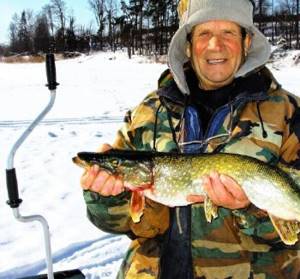
The movement of water in the channel well saturates the zones of the nearest water areas with oxygen. It is worth considering that if at the beginning of the winter season predator bites are often observed in the middle of a flooded forest or snags, then in January, as a rule, the pike stays nearby, in clean water, but always chooses shelter in the form of separate snags or small holes at the bottom. If you can find such places using an echo sounder or some other method, they can be very promising for setting up vents. However, fishing near snags always threatens with snags, because the cunning pike instinctively rushes into the support, therefore, when using ordinary girders, you need not to miss the moment to hook and quickly fish out. If the pike is not pulled onto the ice in time, the tackle installed even near a separate snag may become hopelessly caught, and the trophy will be lost. But when a snag does occur, you should not immediately break off the tackle. Sometimes a hooked girder left for some time unravels itself as a result of pike throwing.
Snags located on an underwater platform, in the corner formed by the edges of the main channel and tributary, are also promising for fishing. The zherlitsy here are also placed taking into account the characteristics of the snag. When fishing in such a zone, if the pike bites sluggishly and moves little, I sometimes make runs along the lines of installation of the girders to force the predator to move. Sometimes this gives a positive result, and the predator that has moved to another point suddenly finds itself biting.
Reservoirs of a special type
There are other types of reservoirs, such as the Verkhneruzskoe reservoir, where water pumping stations are forced to work throughout the winter so that water continuously flows into the Ruza-Yauza technical canal, located on both sides of this reservoir. The current here is constantly observed, and the good saturation of the water with oxygen forces the predator to behave quite actively in winter, often in an autumn-like manner. Pike in reservoirs of this type are sometimes concentrated in snags at shallow depths; at the mouths of tributaries, in shallow irrigation areas and other areas that are not entirely typical for mid-winter. The predator’s routes can also run through deeper places with complex bottom topography. However, this does not mean at all that if you go to such a body of water, you will definitely end up with a trophy. Indeed, on the Verkhneruzsky Reservoir, girders often give better results than anywhere else, but it should be borne in mind that the activity of a toothy fish can be depicted as a sinusoid: after it has filled its belly with food, the pike usually does not feed for several days.
Read: How to slow down the freezing process of a hole
In some reservoirs there are areas of snags in which there are no pike only because these areas are occupied by pike perch or burbot. For example, on the Yauzsky Reservoir, when setting up vents in deep snags, it was the latter that were most often encountered.
On the dams of rivers such as Severka and Lopasnya, a good oxygen regime is maintained under the ice (due to a noticeable current in the riverbed), which makes it possible to actively search for pike throughout the entire water area. For example, at the dam above Khatuni, the flooded river bed is quite winding. It often approaches the shore in arcs, where there are thickets of reeds, local areas of snags and other features. In the irrigation areas there are remnants of a forest that was once cleared. In some places, the wooded shore with trees fallen into the water and submerged bushes creates good hiding places for the predator. Small or medium-sized pike are sometimes caught near a tree or frozen branches of a bush that has fallen into the water and frozen into the ice, especially if it stands above a coastal cliff with a deep bottom that has some peculiarities.
In such areas, in addition to pike, it was possible to catch medium-sized chub. To catch this fish, I use sensitively tuned perch girders with equipment without a leash. You need to look for chub exits, for which you have to frequently rearrange the girders.
In January, attention should be paid to algae zones, especially in flowing reservoirs and dams. Wide “windows” among algae, thickets of pondweed, arrowhead, cattail, uruti, etc. may turn out to be promising for setting up girders, where, under favorable oxygen conditions, food items can live in large numbers, attracting schools of small fish, so there may also be predator. It is worth looking for such zones in unovergrown areas near the mouths of tributaries, next to a bed approaching algae, with dams and other hydraulic structures. Areas near the reeds growing along a narrow “shelf”, behind which there is a drop to depth, may prove to be catchy. In this case, you need to focus on algae that look quite fresh under the ice, and avoid places with rotting algae.
You need to approach a triggered girder, especially one installed in a shallow area, slowly and carefully, otherwise the passive pike may abandon the fry.
On the reservoirs of the Upper Volga cascade, some reservoirs near Moscow, as well as on large lakes in the regions adjacent to the Moscow region, in January it was possible to find pike zones near the islands. Many islands remote from the coast are bordered along the perimeter by algae (urut, mulberry and others), attracting schools of verkhovka, roach, and small perch. Numerous schools of perch gather here to hunt for fry, and pike often watch over plump stripers. The algae bordering the island grow mainly at depths of up to 1.5-2 m. But since the depths around the islands are not the same, and in some places there are small cliffs immediately behind the reeds, bays often form among the algae in which pike can stand. This predator often comes out to hunt on island shallows and spits, especially during prolonged thaws, when melt water seeps under the ice, smelling of thawed coastal vegetation. During such periods, larvae that come to life with warmth enter ice cracks and encourage small fish to feed. Their activity immediately attracts the attention of pike.
Read: Types and designs of girders for pike
“Zubastaya” often stays in the straits between islands, but not everywhere. Of course, you should take into account the water level in the reservoir, which should be high. On the Mozhaisk Reservoir, for example, pike outings in December - January occur in the Krasnovidovo area, where schools of roach and perch gather in the recesses of the bottom in the strait between a small island and the shore. The weather should not be ignored either. If there is frost for a long time, the pike concentrates on the deep channel edges behind the island. A similar picture can be seen in the Vazuzsky, Yauzsky and some other reservoirs.
In January, you can fish well on some oxbow lakes and backwaters of the Oka. It is necessary to look for areas where large depths are adjacent to small ones, and install vents along the slope in a checkerboard pattern. Narrowing oxbow lakes, where narrow “shelves” of watering are adjacent to sharp drops to depth, may be promising for fishing. It is also worth looking for areas with hummocky watering, where forage fish often find food.
Sometimes a good result is achieved by installing girders over the lumpy “tables” of backwaters. There are quite a lot of them on the Oka River, and if you study their topography using an echo sounder, you can catch a lot of fish. By the way, in January, on the Tsimlyansk backwater, craftsmen consistently catch pike perch with the help of girders and balance beams.
On the narrow and long Vazuzsky reservoir, pike can be caught well from November to January on sharp slopes of the riverbed, which often go immediately from the shoreline. At one time I went to a site whose feature was a cascade-step dump. Its length along the coast was several tens of meters. It was on it, especially on the first ice, that a lot of pike gathered. Later, the bite weakened, but still in December and January it was usually possible to catch several pikes during fishing. The predator was measured, and in addition, it was possible to simultaneously catch large bream in the nearby riverbed depths, so the trips turned out to be very effective. If at the beginning of winter bites more often occurred in the zone of the first and second “shelves”, at depths of 1.5-4 m, then by the end of December and in January - at depths of 5-8 m, in the riverbed zone or near it.
Read: Catching pike perch in snags
It was also possible to find pike dumps at the Istra Reservoir. Here, along the shore near the village of Pokhlebaiki, there is a flooded riverbed, in places heavily overgrown with reeds. In a narrow watering hole on the shore side in December - January, schools of perch of various sizes actively feed, attracting pike here. The predator, however, is usually small. At the riverbed depths, schools of roach and bream gather to bait fishermen; the “toothy” one is also partial to these fish. Therefore, when placing the girders on the pike, I usually took into account different depths here. At the same time, he installed the girders taking into account the features of the relief. If I found a “table” with an uneven bottom in an area where the channel approached a narrow bay, I placed the girders here more densely. When, along the edge of the main flooded channel, the irrigation bottom did not stand out much, he installed the girders in a checkerboard pattern: one girder for irrigation from the bank side, the other on the channel, and the spacing of the gear could be quite wide. In such cases, a couple of girders should also be installed above deep watering, but again taking into account the concentration of roach, perch or underbream.
In January–February, in many reservoirs, pike are found on deep edges distant from the shore.
For example, on the Vazuz reservoir, large pike weighing 2-6 kg could be caught by installing girders in a checkerboard pattern, capturing the upper and lower edges. The fishing depth was usually 5.5-10 m. On such edges, at some distance from the pike places, pike perch were sometimes caught. Usually the edges were not distinguished by the features of the relief, the pike simply pecked at certain points. To find the “golden point,” it was necessary to immediately drill two or three rows of widely spaced holes, and then, during the hours when pike biting activity usually falls, rearrange the girders with a certain periodicity. The January pike biting time is usually from 9 to 11 and from 13 to 14 hours. Very rarely pike is caught at night and in the evening.
In addition to the considered areas for setting up pike vents, other promising areas can be noted: • exits of tributary beds from ravines; • flooded ditches and channels, which are found in some reservoirs; • hummock zones; • holes distant from the shore; • unremarkable flat bottom far from the shore (on reservoirs and large lakes); • shallow water areas near the coastal edge (during thaw).
Features of fishing in such places are the topic of another article. In general, a detailed study of promising zones on a particular body of water always gives a positive result, and a fisherman-researcher rarely ends up without a catch.
snag
